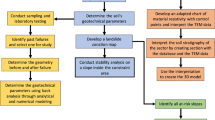Abstract
Physically based models are capable of evaluating the effects of environmental changes through adaptations in their parameters. For landslide hazard zonation, this gives them an edge over traditional, statistically based techniques that require large datasets and often lack the objectivity to achieve the same purpose. Therefore, physical models can be valuable tools for hazard assessment and planning purposes.The usefulness of the model prognosis depends largely on the ability of the physical model to mimic the landscape system. This implies that the model should be calibrated and validated and that the imposed changes do not lead to a radical departure from the present situation.Under the recognition of these constraints, a physically based model has been applied to a 1.5 km2 catchment in the Alcoy region (SE Spain) to evaluate the effects of land use change on landslide activity. The model couples a transient, distributed hydrological model with a probabilistic assessment of the slope stability. Thus, it is able to assess the spatial and temporal activity of slope instability. For the present situation, validation demonstrates that the probability of failure returns a conservative estimate of the spatial frequency of landsliding. The model has subsequently been applied to two hypothetical land use change scenarios that extrapolate present and likely trends. For these scenarios, the model results indicate a marginal decrease in the spatial frequency of landsliding (aerial extent of instability). However, the decrease in the temporal activity (is total duration of instability over a given period) is substantial under the altered land use conditions. The forecasted change in landslide activity not only affects the relative weight of slope processes in the region. It also has implications for the perceived hazard levels and the landslide hazard zonation of the area.
Similar content being viewed by others
References
Brunsden, D.: 1993, Barriers to geomorphological change, In: D. S. G. Thomas and R. J. Allison (eds), Landscape Sensitivity, Wiley, Chichester, pp. 7–12.
Carrara, A. M., Carinali, F., Guzzetti, F., and Reichenbach, P.: 1995, Gis based techniques for mapping landslide hazard, in A. M. Carrara and F. Guzzetti (eds), Geographical Information Systems in Assessing Natural Hazards, Kluwer, Dordrecht, pp. 135–176.
Farrel, D. and W. Larson: 1972, Modeling the pore structure of porous media, Water Resources Research 8, 699–705.
Fredlund, D. G.: 1987, Slope stability analyses incorporating the effect of soil moisture suction, in M. G. Anderson and K. S. Richards (eds), Slope Stability, Wiley and Sons, Chichester, pp. 113–144.
Kessler, J. and R. Oosterbaan: 1974, Determining hydraulic conductivity's of soils, in Drainage principles and applications, 16,III, International Institute for land reclamation and improvement, Wageningen, The Netherlands, pp. 253–296.
La Roca-Cervigón, N.: 1991, Untersuchungen zur räumlichen und zeitlichen Variabilität der Massenbewegungen im Einzugsgebiet der Riu d'Alcoi (Alicante, Ostspanien), Die Erde 122, 221–236.
La Roca-Cervigón, N.: 1992, Precipitaciones mediterráneas y movimientos de masa en margas de los Valles de Alcoy, Universidad de Valencia, Saitabi, XVII, 1–26, (in Spanish).
Lee, I. K., White, W., and Ingles, O. G.: 1983, Geotechnical Engineering, Pitman, Boston, 508 pp.
Merriam, R. A.: 1961, A note on the interception loss equation, J. Geoph. Res. 65, 3850–3855.
Millington, R. J. and Quirk, J. P.: 1959, Permeability of porous media, Nature 183, 387–388.
Okunishi, K. and Okimura, T.: 1987, Groundwater models for mountain slopes, In: M. G. Anderson and K. S. Richards (eds), Slope Stability, Wiley and Sons, Chichester, pp. 265–284.
PCRaster: 2000, PCRaster Environmental Software, Manual version 2, Faculty of Geographical Sciences, Utrecht University, 367 pp.
Penman, H. L.: 1948, Natural evaporation from open water, bare soil and grass, Proceedings of the Royal Society A193, pp. 120–145.
Rodda, H. J. E., Stroud, M. J., Shanker, U., and Thorold, B. S.: 2001, A GIS base approach to modelling the effects of land use change in New Zealand, Soil use and Management 17, 30–40.
Skempton, A. W. and Delory, F. A.: 1957, Stability of natural slopes in London clay, Proc. 4th Int. Conf. SMFE, London, 2, pp. 63–70.
Soeters, R. and Van Westen, C. J.: 1996, Slope instability tecognition, analysis and zonation, in A. K. Turner and R. L. Schuster (eds), Landslides; Investigation and Mitigation, Special report 247, Transport Research Board, National Academy Press Washington D.C., pp. 129–177.
Terlien, M. T. J., Van Asch, Th. W. J., and Van Westen, C. J.: 1995, Deterministic modelling in GIS-based landslide hazard assessment, in A. M. Carrara and F. Guzzetti (eds), Geographical Information Systems in Assessing Natural Hazards, Kluwer, Dordrecht, pp. 57–77.
Terlien, M. T. J.: 1996, Modelling spatial and temporal variations in rainfall-triggered landslides, ITC, Enschede, 32, 254 pp.
Van Asch, Th. W. J. and Van Steijn, H.: 1991, Temporal patterns of mass movements in the French Alps, Catena 18, 515–527.
Van Asch, Th. W. J., Kuipers, B., and Van der Zanden, D. J.: 1993, An information system for large scale quantitative hazard analyses of landslides, Zeitschr. f. Geomorph. 87, 133–140.
Van Asch, Th. W. J., Buma, J., and Van Beek, L. P. H.: 1999, A view on some hydrological triggering systems in landslides, Geomorphology 30, 25–32.
Van Beek, L. P. H.: 2002, The effect of land use and climatic change on slope stability in the Alcoy region (Spain), Thesis, Faculty of Geographical Sciences, Utrecht University, The Netherlands, 363 pp.
Veldkamp, A. and Fresco, L. O.: 1996, CLUE: A conceptual model to study the conversion of land use and its effects, Ecolog. Modelling 85, 253–270.
Wesseling, C. G, Karssenberg, D., Van Deursen, W. P. A., and Burrough, P. A.: 1996, Integrating dynamic environmental models in GIS: the development of a dynamic modelling language, Trans. In GIS 1, 40–48.
Author information
Authors and Affiliations
Rights and permissions
About this article
Cite this article
Van Beek, L., Van Asch, T. Regional Assessment of the Effects of Land-Use Change on Landslide Hazard By Means of Physically Based Modelling. Natural Hazards 31, 289–304 (2004). https://doi.org/10.1023/B:NHAZ.0000020267.39691.39
Issue Date:
DOI: https://doi.org/10.1023/B:NHAZ.0000020267.39691.39




